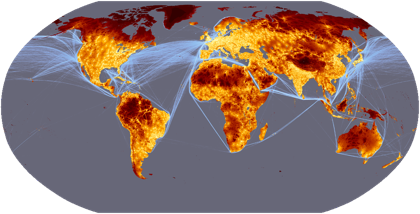At a glance: How soon can I get there?

A new map of Travel Time to Major Cities - developed by the European Commission and the World Bank - captures this connectivity and the concentration of economic activity and also highlights that there is little wilderness left... accessibility is relevant at all levels, from local development to global trade and this map fills an important gap in our understanding of the spatial patterns of economic, physical and social connectivity.The creators of this map went beyond simple considerations of road mileage and cities' distance from the coast to calculate a more complex measure of "friction surface" — in other words, how long it really takes to cover a given mile of terrain. Among the other factors that add to travel time (i.e., friction) are topography, national borders (the crossing of which can cause delays), and land cover. (Check out the data sources page to see where all that information originated, and what the data's parameters are.)
Kudos to the mapmakers for the aesthetic choices, too. The coloration is coherent and seamless, yet the viewer can easily distinguish among the zones. The gradual transitions from one zone to the next are clear.
This is a very thoughtful project that goes beyond careful data selection to incorporate practical considerations as well — thereby creating a very useful tool.
Travel time to major cities: A global map of Accessibility — European Commission Global Environment Monitoring
[Via enrevanche]


Comments
Post a Comment